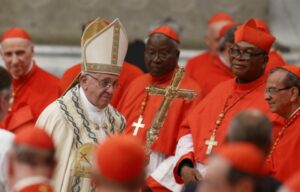Francis has opened the Vatican’s top leadership to women. Are lay cardinals next?
 Pope Francis is reorganizing the Vatican Curia — the church’s administrators and his senior staff — and may name new cardinals in June.
Pope Francis is reorganizing the Vatican Curia — the church’s administrators and his senior staff — and may name new cardinals in June.
Francis’ new apostolic constitution, “Praedicate Evangelium” (“Preach the Gospel”), issued last month, noted that the heads of dicasteries and other offices that manage the church need not be ordained. This highlighted Francis’ stated aim to give “more space” to women in the church.
Most of the important dicasteries are as a matter of fact headed by cardinals. But if any Catholic can head a curial office, the question becomes, does the title come with the job? More importantly, is the title needed to do the job?
If the main duty of a cardinal is to be an adviser to the pope, and there is no ordination required, it could make sense to restart the tradition of lay cardinals and to include women in the mix.
Since the 16th century, cardinals have come mostly from the ranks of priests and bishops, but this has not always been the case.
Some Spanish and Italian royals were created cardinals in the medieval church. More recently, Pope Pius IX named the curial lawyer Teodolfo Mertel a cardinal, two months before ordaining him deacon in 1858.
Mertel was not exactly a lay cardinal — he received clerical tonsure, a rite just short of ordination, in his late 30s — but he remained a cardinal deacon for the rest of his life.
As auditor of the papal treasury, he oversaw a good part of the Vatican’s money.
There is even historical evidence of female deacons doing much the same. A sixth-century inscription recalls the Deacon Anna, who, with her brother, appears to have served as the treasurer of Rome.